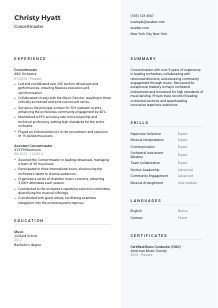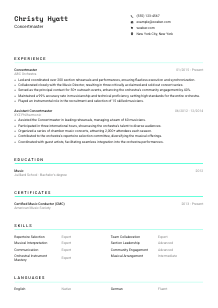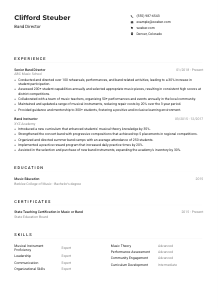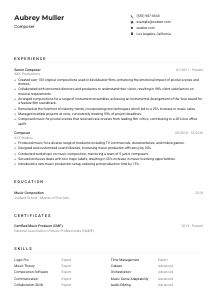Concertmaster Resume Example
Leading the strings, but your resume isn't striking a chord? Play along with this Concertmaster resume example, orchestrated using Wozber free resume builder. Learn how to compose your leadership and musical prowess to resonate with symphonic job calls, making your career crescendo as harmoniously as the first violins!
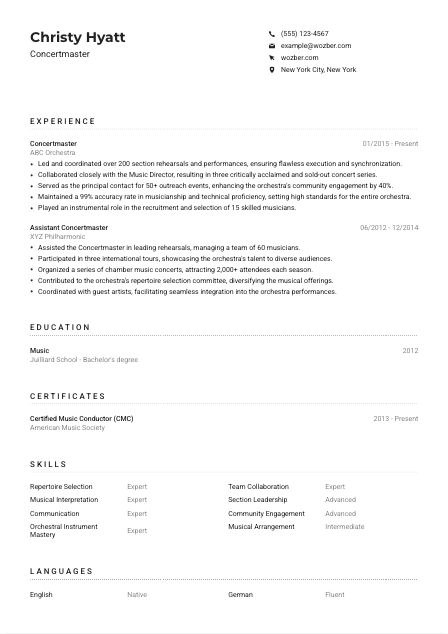
How to write a Concertmaster resume?
Stepping into the spotlight as a Concertmaster requires not just impeccable musicianship but also a resume that orchestrates your skills, experiences, and qualifications into a harmonious portfolio. Today, let's fine-tune your resume with the precision of a maestro, aligning it to the crescendos and decrescendos of the job market's demands. Utilizing Wozber, the free resume builder with built-in ATS resume scanner, this guide will help you compose an ATS-compliant resume that resonates with the tune of success. So, rosin up your bow, it's time to make your application sing!
Personal Details
Your resume's Personal Details section sets the stage for your professional symphony. Consider it the opening note that captures the audience's attention. Let's delve into how to conduct this section with the grace and expertise of a true Concertmaster.
1. Command with Your Name
Think of your name as the title of your first symphony - it needs to be memorable. Use a font that's clean and bold, setting the stage for your personal brand. Just as you would tune your instrument before a performance, ensure your name is finely presented.
2. Harmonize with Your Role
Below your name, clearly state your desired position - "Concertmaster." This instant harmony between your profile and the desired role sings to the hiring manager that you're precisely what they've been listening for.
3. Fine-tune Your Contact Info
Ensure your contact information strikes the right chord by including a professional email and a phone number without any dissonances - no nicknames or casual IDs. A harmonious email format like firstname.lastname@email.com sets a professional timbre from the outset.
4. Compose Your Locality
Just as a great concert hall's location is crucial, so is yours. Highlight your New York City, New York location to play in unison with the job's geographical requirement, removing any doubt about relocation.
5. Encore with a Professional Profile
In today's digital age, including a LinkedIn profile could be your encore, offering a deeper insight into your professional achievements. Ensure it's a mirror reflection of your resume to maintain consistency and professionalism.
Takeaway
Imagine your Personal Details as the opening bars of a piece; it must set the tone for what's to come. Craft it with the same attention to detail you would give to your instrument, ensuring each part of this section plays perfectly to your strengths.





Experience
The Experience section is your solo debut on the stage of your career. It's where you demonstrate not just participation, but leadership, musicianship, and the achievements that spotlight your qualifications for the Concertmaster role.
- Led and coordinated over 200 section rehearsals and performances, ensuring flawless execution and synchronization.
- Collaborated closely with the Music Director, resulting in three critically acclaimed and sold‑out concert series.
- Served as the principal contact for 50+ outreach events, enhancing the orchestra's community engagement by 40%.
- Maintained a 99% accuracy rate in musicianship and technical proficiency, setting high standards for the entire orchestra.
- Played an instrumental role in the recruitment and selection of 15 skilled musicians.
- Assisted the Concertmaster in leading rehearsals, managing a team of 60 musicians.
- Participated in three international tours, showcasing the orchestra's talent to diverse audiences.
- Organized a series of chamber music concerts, attracting 2,000+ attendees each season.
- Contributed to the orchestra's repertoire selection committee, diversifying the musical offerings.
- Coordinated with guest artists, facilitating seamless integration into the orchestra performances.
1. Compose with the Job in Mind
Dissect the job description like a score, finding the melodies - or requirements - you need to reflect. The need for "exceptional mastery of a major orchestral instrument" and "proven leadership abilities" must echo through your experience.
2. Arrange Your Positions
List your roles in a chronological crescendo, starting with your current or most recent engagement. This organizational method lets the reader follow the natural progression of your career like movements in a symphony.
3. Harmonize Your Achievements
For each position, curate achievement statements that resonate with the job's requirements. Describe leading over "200 section rehearsals and performances" to showcase not just your participation, but your leadership and impact.
4. Accentuate with Numbers
Quantify your achievements wherever possible. Numbers are the dynamics in your performance- they amplify your contributions and provide a clear measure of your impact, like "enhancing the orchestra's community engagement by 40%.
5. Maintain Relevance
Ensure every note in this section contributes to your narrative as a Concertmaster. Extraneous information dilutes your message. Stay focussed on your musicianship, leadership, and community engagement.
Takeaway
Craft your Experience section with the artistry you'd apply to a solo performance. Let your career's high notes sing out, proving your qualifications through quantifiable achievements and relevant experiences. This is your moment in the spotlight, make every note count.
Education
In the symphony of your resume, the Education section supports your professional experience like the underlying harmonies in an orchestral piece. It amplifies your qualifications and sets the foundation for your abilities.
1. Identify the Prerequisites
Begin by isolating the educational requirements from the job description, such as the "Bachelor's degree in Music." This ensures your resume resonates with the specific needs of the role.
2. Score Your Credentials
Arrange your educational background in a clear, legible manner. Start with the degree, then the field of study, followed by the institution and your graduation year, composing a harmonious outline of your academic achievements.
3. Solo on Your Degree
Your Bachelor's degree in Music takes center stage here. Place it prominently to immediately connect your qualifications with the job's requirements, orchestrating a strong case for your candidacy.
4. Embellish with Relevant Courses
If your career is in its early overtures, including significant coursework can add depth to your academic profile, much like a cadenza adds flair to a concerto. Highlight courses directly related to orchestral performance or leadership.
5. Fortissimo with Achievements
If you've graduated with honors or participated in notable music clubs or societies, let these achievements ring out. They add volume to your qualifications, especially for roles looking for proven leaders and exceptional talents.
Takeaway
Your Education section should sing in harmony with the rest of your resume, reinforcing your qualifications for the Concertmaster role. Well-arranged and focused, it builds the foundation upon which your professional experiences can shine.
Certificates
Certificates in your resume act like the high notes in a musical piece - they can make your application soar above the rest by showcasing your dedication to continuous improvement and your mastery in specific areas.
1. Select Your Repertoire
Choose certificates that are most relevant to the Concertmaster role. While the job posting may not specify required certifications, ones that demonstrate leadership or advanced musical skills will reinforce your expertise.
2. Arrange with Precision
List your certifications in a way that each one clearly indicates your advanced knowledge and ongoing commitment to your craft. Include the issuing organization and the date to provide context and credibility.
3. Keep the Tempo
Regularly update and add to your certifications to show a commitment to lifelong learning. The world of music evolves, and staying attuned with contemporary practices demonstrates your adaptability and dedication.
4. Crescendo in Learning
Pursue new learning opportunities that can enhance your career as a Concertmaster. Whether it's leadership, music theory, or performance mastery, each certificate adds a note of credibility to your professional symphony.
Takeaway
Each certificate is a high note in the melody of your career, emphasizing your dedication and depth of knowledge. This section should sing of your continuous efforts to refine your craft and lead with confidence.
Skills
Your skills section is like the cadenza of your resume - a moment for your individual talents to shine and demonstrate your unique contributions to the orchestral world. Let's ensure it's composed to impress.
1. Tuning into the Job Description
Begin by extracting both explicit and implied skills from the job description. Leadership skills, interpersonal communication, and mastery of your instrument are themes that should resonate throughout your skills section.
2. Arranging Your Major and Minor Skills
List your skills beginning with those most pertinent to being a Concertmaster, like "Repertoire Selection" and "Orchestral Instrument Mastery." Then, weave in soft skills such as "Communication" and "Team Collaboration" to create a comprehensive portrait.
3. Keeping the Ensemble in Mind
Focus on skills that reflect your ability to lead and work within an ensemble, just as you would within an orchestra. This shows not just your individual capabilities but also your understanding of the collaborative nature of music.
Takeaway
Like a well-composed cadenza, your skills section should highlight your virtuosity, both as a musician and as a leader. Craft it carefully to showcase the range and depth of your talents, making a compelling case for your candidacy as a Concertmaster.
Languages
As music is a universal language, your ability to communicate effectively in multiple tongues can greatly enhance your appeal, especially in roles that involve community engagement and international collaboration.
1. Assessing the Score
First, note any specific language requirements or benefits stated in the job description. For a Concertmaster, clear and effective English communication is essential, but additional languages can also be beneficial for community engagement.
2. Highlighting Your Linguistic Talent
Place your language proficiencies prominently, beginning with those most relevant. If English is your native language, list it first, followed by any additional languages, marking your proficiency level accurately.
3. Fluent Phrases and Basic Beats
Be truthful about your language abilities, as fluency can range from conversational to bilingual standards. Accurately depicting your skill level respects the nuances of linguistic proficiency.
4. Engaging in Diverse Dialogues
For a role that encompasses outreach and educational initiatives, showcasing your linguistic diversity could open the door to more genuine and impactful community interactions, harmonizing perfectly with the role's responsibilities.
5. Continuously Learning New Scores
Embrace the opportunity to learn and improve your language skills, enhancing your ability to engage with a wider audience, both within and beyond the concert hall.
Takeaway
Your linguistic skills can play a pivotal role in your resume, offering a glimpse into your ability to communicate and connect across cultures. Just as music transcends borders, so too can your command of languages, opening new opportunities for engagement and education.
Summary
Your resume's summary offers a prelude to your professional narrative, setting the tone for the detailed accomplishments that follow. It's your moment to command attention and entice the audience to listen deeply.
1. Decoding the Composition
Start by absorbing the essence of the Concertmaster position, familiarizing yourself with the required scales and arpeggios of skills and experiences needed to excel in the role.
2. Crafting Your Opening Notes
Introduce your professional self with a concise statement that encapsulates your experience and expertise. Aim for a compelling melody that draws the reader in, showcasing your unique contributions to the musical world.
3. Highlighting Your Solo Passages
Spotlight key moments from your career that align with the Concertmaster's duties. Noteworthy achievements, such as leading successful concert series and enhancing community engagement, demonstrate your capability and influence.
4. Concluding With a Crescendo
Wrap up your summary with a powerful statement that leaves the reader eager to dive deeper into your resume. Like a well-crafted symphony, ensure your summary builds anticipation for the movements that follow.
Takeaway
Craft your summary to resonate with the essence of your professional journey, striking a chord with the hiring manager by hinting at the depth of your talents and experiences. It's your opportunity to ensure your resume starts on a high note, leading the way to a standing ovation at the interview.
Launching Your Concertmaster Journey
Congratulations, maestro! With this finely tuned resume, you're ready to take center stage in the job market's orchestral pit. By using Wozber, you've crafted an ATS-compliant resume that sings your praises in the proper key for the Concertmaster role. Now, take a bow, and step confidently into your next audition.
Remember, the world's stages await your brilliance, and your skillfully composed resume is the ticket to your next grand performance. Go forth and let your musical career soar to new heights!

- Bachelor's degree in Music or relevant field.
- Minimum of 8 years of playing experience with a professional orchestra.
- Exceptional mastery of a major orchestral instrument.
- Proven leadership abilities and experience leading a section or ensemble.
- Strong interpersonal and communication skills.
- Clear and effective English communication skills necessary.
- Must be located in New York City, New York.
- Lead and coordinate section rehearsals and performances.
- Collaborate with the Music Director and other artistic staff in repertoire selection and programming decisions.
- Serve as the principal contact for outreach events, educational programs, and community engagements.
- Maintain a high level of musicianship and technical proficiency as an exemplary role model for the orchestra.
- Participate in auditions and make recommendations for section personnel changes when necessary.






